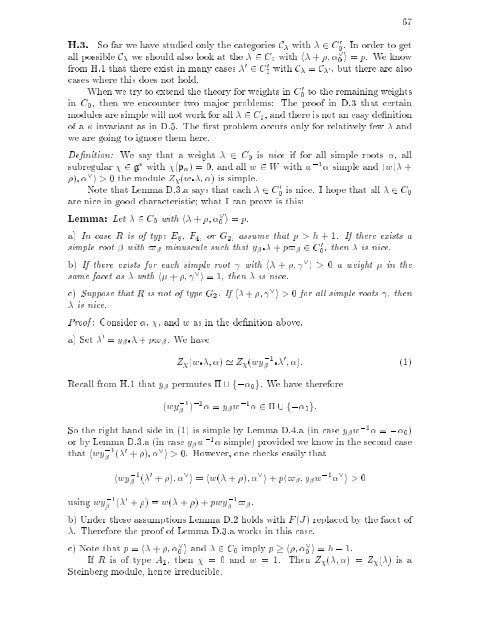subregular nilpotent representations of lie algebras in prime ...
subregular nilpotent representations of lie algebras in prime ...
subregular nilpotent representations of lie algebras in prime ...
You also want an ePaper? Increase the reach of your titles
YUMPU automatically turns print PDFs into web optimized ePapers that Google loves.
H.3. So far we havestudied only the categories C with 2 C 0 0. In order to get<br />
all possible C we should also look at the 2 C0 with h + ; _ 0 i = p. Weknow<br />
0 0 from H.1 that there exist <strong>in</strong> many cases 2 C0 with C = C 0, but there are also<br />
cases where this does not hold.<br />
When we try to extend the theory for weights <strong>in</strong> C 0 0 to the rema<strong>in</strong><strong>in</strong>g weights<br />
<strong>in</strong> C0, then we encounter two major problems: The pro<strong>of</strong> <strong>in</strong> D.3 that certa<strong>in</strong><br />
modules are simple will not work for all 2 C0, and there is not an easy de nition<br />
<strong>of</strong> a <strong>in</strong>variant as <strong>in</strong> D.5. The rst problem occurs only for relatively few and<br />
we are go<strong>in</strong>g to ignore them here.<br />
De nition: We say that a weight 2 C0 is nice if for all simple roots , all<br />
<strong>subregular</strong> 2 g with (p ) = 0, and all w 2 W with w ,1 simple and hw( +<br />
); _ i > 0 the module Z (w ; ) is simple.<br />
Note that Lemma D.3.a says that each 2 C 0<br />
0 is nice. I hope that all 2 C0<br />
are nice <strong>in</strong> good characteristic; what I can prove is this:<br />
Lemma: Let 2 C0 with h + ; _ 0 i = p.<br />
a) In case R is <strong>of</strong> type E8, F4, orG2, assume that p>h+1. If there exists a<br />
simple root with $ m<strong>in</strong>uscule such that y + p$ 2 C 0 0 , then is nice.<br />
b) If there exists for each simple root with h + ; _ i > 0 a weight <strong>in</strong> the<br />
same facet as with h + ; _ i =1,then is nice.<br />
c) Suppose that R is not <strong>of</strong> type G2. Ifh + ; _ i > 0 for all simple roots , then<br />
is nice.<br />
Pro<strong>of</strong> : Consider , , and w as <strong>in</strong> the de nition above.<br />
a) Set 0 = y + p$ .Wehave<br />
Z (w ; ) ' Z (wy ,1 0 ; ): (1)<br />
Recall from H.1 that y permutes [f, 0g. Wehave therefore<br />
(wy ,1 ) ,1 = y w ,1 2 [f, 0g:<br />
So the right hand side <strong>in</strong> (1) is simple by Lemma D.4.a (<strong>in</strong> case y w ,1 = , 0)<br />
or by Lemma D.3.a (<strong>in</strong> case y w ,1 simple) provided we know <strong>in</strong> the second case<br />
that hwy ,1 ( 0 + ); _ i > 0. However, one checks easily that<br />
hwy ,1 ( 0 + ); _ i = hw( + ); _ i + ph$ ;y w ,1 _ i > 0<br />
us<strong>in</strong>g wy ,1 ( 0 + )=w( + )+pwy ,1 $ .<br />
b) Under these assumptions Lemma D.2 holds with F (J) replaced by the facet <strong>of</strong><br />
. Therefore the pro<strong>of</strong> <strong>of</strong> Lemma D.3.a works <strong>in</strong> this case.<br />
c) Note that p = h + ; _ 0 i and 2 C0 imply p h ; _ 0 i = h , 1.<br />
If R is <strong>of</strong> type A1, then = 0 and w =1. Then Z ( ; )= Z ( )isa<br />
Ste<strong>in</strong>berg module, hence irreducible.<br />
67

















